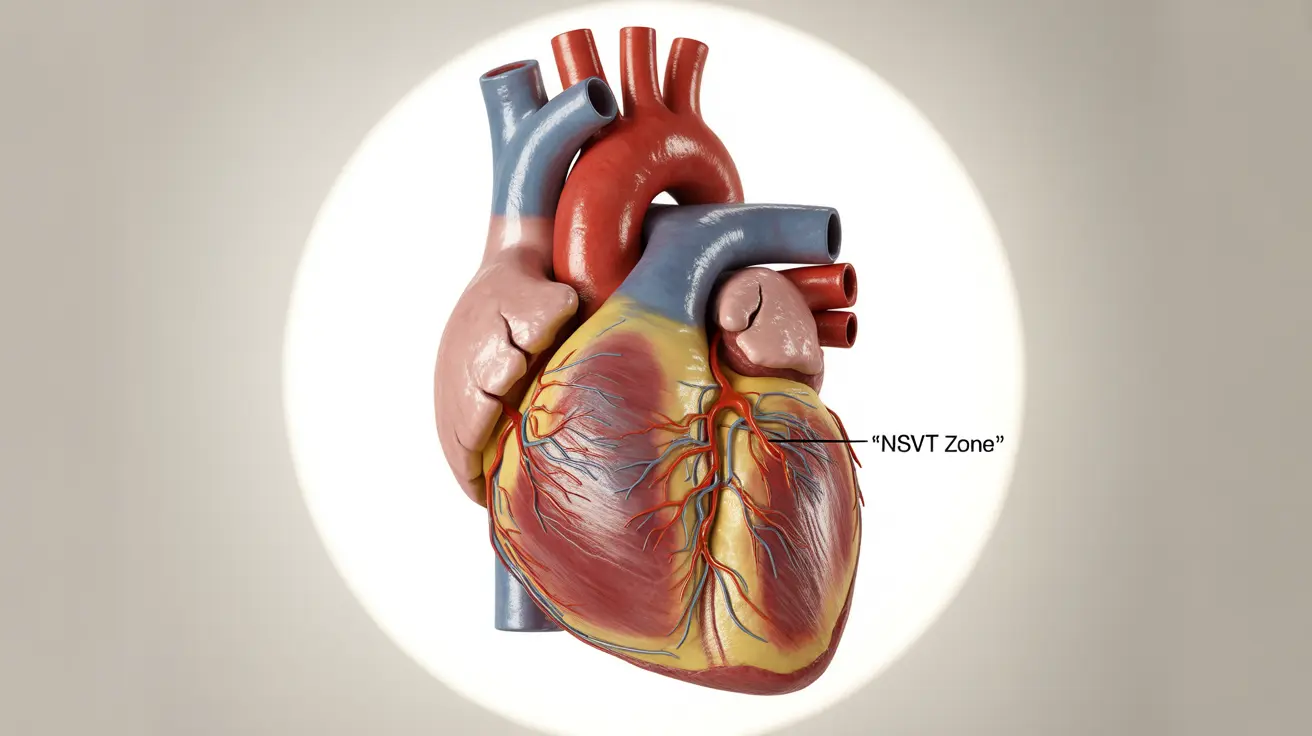Nonsustained ventricular tachycardia (NSVT) is a heart rhythm disorder characterized by three or more consecutive heartbeats originating from the ventricles at a rapid rate, lasting less than 30 seconds. While NSVT episodes often resolve on their own, understanding this condition is crucial as it can indicate underlying heart problems and may require medical attention.
This comprehensive guide explores the key aspects of NSVT, including its symptoms, causes, diagnosis, and treatment options, helping you better understand this cardiac condition and when to seek medical care.
Common Symptoms of NSVT
Many people with NSVT may experience no symptoms, especially if episodes are brief. However, when symptoms do occur, they can include:
- Palpitations or racing heartbeat
- Chest discomfort or pain
- Dizziness or lightheadedness
- Shortness of breath
- Fatigue
- Near-fainting episodes (presyncope)
- Fainting (syncope) in severe cases
The severity and presence of symptoms often depend on factors such as the duration of the episode, underlying heart conditions, and the individual's overall health status.
Causes and Risk Factors
NSVT can occur in people with or without existing heart conditions. Common causes include:
Structural Heart Conditions
- Coronary artery disease
- Previous heart attack
- Cardiomyopathy
- Heart valve disease
Other Contributing Factors
- Electrolyte imbalances
- Medication side effects
- Excessive caffeine or alcohol consumption
- Severe stress
- Sleep apnea
Risk factors that may increase the likelihood of developing NSVT include advanced age, family history of heart disease, obesity, and certain lifestyle factors such as smoking or excessive alcohol consumption.
Diagnosis and Testing
Diagnosing NSVT typically involves several medical tests and procedures:
Primary Diagnostic Tools
- Electrocardiogram (ECG)
- Holter monitor
- Event recorder
- Exercise stress test
Additional Assessments
- Echocardiogram
- Cardiac MRI
- Blood tests for electrolyte levels
- Cardiac catheterization in some cases
Treatment Approaches
Treatment for NSVT varies depending on the underlying cause and the presence of structural heart disease. Common treatment strategies include:
Conservative Management
- Regular monitoring
- Lifestyle modifications
- Stress reduction techniques
- Management of underlying conditions
Medical Interventions
- Antiarrhythmic medications
- Beta-blockers
- Treatment of underlying heart conditions
- Implantable cardioverter-defibrillator (ICD) in high-risk cases
Frequently Asked Questions
What are the common symptoms of nonsustained ventricular tachycardia (NSVT)?
Common symptoms include palpitations, chest discomfort, dizziness, shortness of breath, and fatigue. However, some people may experience no symptoms at all, particularly during brief episodes.
What causes nonsustained ventricular tachycardia and who is at risk for developing it?
NSVT can be caused by structural heart conditions like coronary artery disease, cardiomyopathy, or previous heart attacks. Risk factors include advanced age, family history of heart disease, and certain lifestyle factors. People with existing heart conditions are at higher risk.
How is nonsustained ventricular tachycardia diagnosed and what tests are involved?
Diagnosis typically involves ECG monitoring, Holter monitors, event recorders, and stress tests. Additional testing may include echocardiograms, cardiac MRI, and blood tests to evaluate overall heart health and identify underlying causes.
What treatment options are available for NSVT, especially if there is underlying heart disease?
Treatment options range from conservative management to medical interventions, including antiarrhythmic medications, beta-blockers, and in some cases, implantable cardioverter-defibrillators. The specific treatment approach depends on the underlying cause and individual risk factors.
Can nonsustained ventricular tachycardia lead to serious complications or affect life expectancy?
While NSVT itself may not always be immediately dangerous, it can indicate underlying heart problems that require attention. The impact on life expectancy largely depends on the presence and severity of underlying heart disease and how well the condition is managed with appropriate treatment.




